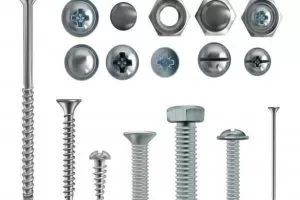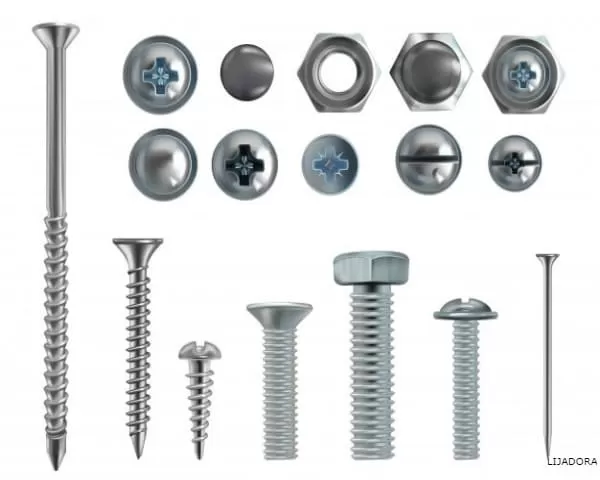By Definition the Screw is a short, thin, pointed metal pin with a raised helical wire around it and a slotted head, which is used to hold things together by turning them so that they will puncture the wood or other material and stay firmly in place.
Types of Screws
Screws are predominantly used to attach materials and hold objects in place. They are distinguished by the presence of a circular / helical crest, denoted as the male (external thread). Some screws have threads that are designed exclusively to match a compatible thread, i.e., the female thread. Others are made for the purpose of penetrating soft materials when the screw is being injected.
Mainly, screws can work due to the presence of the threaded part, which allows them to pierce materials. This functionality in turn results in the use of screws to join surfaces and hold them in place. The different types of screws can be divided into different categories according to the method of driving the screw, the shape of the head and the working requirement it meets.
Wood Screws
Screws used in wood come in various types and sizes of heads. Made of thick threads to obtain a good grip when penetrating the wood. Wood screws are designed for use in hard and soft wood, MDF and particleboard. They have a tapered body, thick threads and a sharp point.
Machine Screws
Metal screws are used for metal working and are designed to be inserted into a threaded hole or tightened with a nut. They usually have a straight body and a flat tip.
Special Screws
Mirror screw, cover screw, masonry screw and drywall screw, there are many different types of special screws for applications such as drywall, decking, masonry and ceramic.
Flat Head Screw
The flat screw heads are completely flush with a surface, leaving no exposed heads. The advantage of flat screws is that you don’t have to worry about the screw protruding from the surface and causing other things to catch on it, which is essential if you’re creating your own sofa or building a shelf for people to walk on often.
Screw Table
To clamp workpieces on the machine tool tables, presses with smooth hardened steel jaws and flat bases are used. These machine presses are portable, but can be clamped to the machine table when in use.
Means can also be provided to turn the active part of the vise so that the workpiece can be held in a variety of positions relative to the base. Special jaws can be provided for clamping workpieces that cannot be held in flat jaws.
Anti-Theft Screw
These screws are used to prevent thefts from removing important items. They can be held in place with a slotted screwdriver, but the screw head prevents removal by turning counterclockwise.
They are suitable for use on most vehicle license plates, as well as in applications where theft or vandalism is common and expected, such as wall-mounted safes and public bathroom fixtures.
Torx screw
The Torx screw head system is in the shape of a six-point star, and for many users it is simply known as a star screw that requires screwdrivers to be screwed in.
These types of screws are used in cars, motorcycles, consumer electronics, computer hard drives and are increasingly common in home construction.
Round Head Screw
It provides a deeper groove capacity than the tray and is therefore more often used in wood screws and machine screws. Made from a dome-shaped head.
A domed head has a round top with a flat bottom surface. Unlike a countersunk screw, a domed head screw is above the work surface and is used when a more decorative finish is required.
Hexagonal Head Screw
Made from a hexagonal head. It consists of six side heads. Commonly used for wood or metal applications. This type of head sits on the surface of the material and is usually found on larger screws, as it allows more torque to be applied when tightening.
Countersunk Head Screw
A countersunk head has a flat top that narrows towards the shank. A countersunk head is aligned with the surface of the material rather than protruding above it like other types of screws.
As a result, countersunk heads are commonly used in fittings where the screw must be partially or completely hidden.
Countersunk heads are often used in both soft and hard woodworking applications.
Hexagon socket head screw
These types of screws have hexagonal shaped holes that are normally used with an Allen key. Tightening or loosening is done with a socket wrench.
Hammer Head Screw
Universal fixing element. The hammerhead screw is twisted into the groove profile and can be mounted into an existing system at a later date. The grooves break the anodised film and create a safe, electrically conductive connection.
Worm screw
screwed on so that it cannot move longitudinally while turning. Therefore, instead of the usual action where a screw advances through a medium as it turns.
The screw remains stationary and forces the medium or a mechanical part to advance. When such a screw is arranged to drive a gear whose teeth engage with its thread, the screw is called a worm gear.
Screw Thread Plate
A self-tapping screw can simply be referred to as a tapping screw. However, it is also often referred to as a sheet metal screw because it is mainly used in sheet metal.
Whatever name is used, these names are for screws that form coupling threads in a pre-drilled hole in the substrate in which they move.
Square Head Screw
This type of screw has a square recess in the head that decreases the chances of slippage. It is also known as a Robertson unit.
Rarely seen now, except on some mining specials with floors.
They were used on wooden bridges and where a larger bearing surface was required.
How to Remove a Sweep Screw ?
- Drill into the screw
- Damaged screws are removed by drilling into the screw with a drill bit, then using a special screw drill bit that tapers and has opposite threads to the screw.
- That is, cut a notch in the screw head using a dremel or hacksaw to cut a notch in the screw head and then use a bladed screwdriver to remove it.
- The removal process should be done slowly and carefully because the removal process is more fragile than normal screw insertion.
How to Remove a Broken Screw
- If you find a broken screw, you know how to thwart it and try to remove it. For screws with broken heads, you can use a screw extractor or even just pliers to help you remove it.
- Find a screw extractor. Screw extractors are designed to help you remove broken screws. You can find them at home improvement stores for a relatively low price, and they will make the process easier.
How to Remove a Headless Screw
- Attach the screwdriver or drill bit to the screw head for screws that will not catch. Drip some glue on the head of the screw. Place the drill bit or screwdriver on the head.
- Allow the glue to dry, then try to remove the screw by pressing down on the screw and turning it. Cut a new slot in the top of the screw with a rotary blade if other methods fail.
- If the top of the screw is completely stripped, use a rotary cutter to cut a small strip at the top. Remove the screw with a flathead screwdriver or drill bit.
How to Remove a Rusty Screw
- Apply to the liquid that dissolves the corrosion on the screw. A chemical, but you can also use elements commonly found in your home, such as hydrogen peroxide, lemon juice or common glue.
- Saturate the screw head and surrounding area with the dissolving agent and gently tap the screw head with a hammer. This creates vibrations that allow the agent to work through the threads.
- Try unscrewing and removing the screw. If it is still stuck, add a second application and try to remove the screw again.
- You can also hit the screw head with a hammer to loosen it. As corrosion develops, it forms a seal between the screw and the object containing the screw. Vibrations from the hammer may loosen the screw enough to allow it to be removed.
How to Remove a Tight Screw
- Change screwdrivers. When a screw is removed, try removing it with a different screwdriver. First, try using a shorter screwdriver with a larger head. Apply downward pressure and slowly try to remove the screw.
- If this doesn’t work, try using a screwdriver with a different type of head. If the screw is a Philips head, try a flathead screwdriver. When using a flathead screwdriver, it should be narrow enough to fit inside the entire hole.
- Apply downward pressure and try to remove the screw. Touch the screwdriver to the head with a hammer. Place your screwdriver in the head. Take a hammer and touch the base of the screwdriver. This will house your screwdriver in the head, providing more grip.
- Place the hammer and try to remove the screw, this method works better with soft metal screws.
How to Loosen a Screw?
- Maximize your grip strength. If you can still grip the screw head with a screwdriver, try to remove it one last time by hand. Follow these instructions first to maximize your chances.
- If the screw is attached to metal, spray penetrating oil and let it stand for at least fifteen minutes. Use the largest hand held screwdriver that fits your screw.
- If possible, hold the screwdriver handle with a wrench to get more leverage.
How Do You Measure a Screw?
- Screw gauges are a measure of the size of the head and shaft, and are approximately linear. Screws have three basic measurements: gauge, threads per inch, and shaft length in inches. Therefore, you can also see a measurement as 6-32 x 1 1/2 “.
- This means that it is a #6 gauge, with 32 threads per inch (almost twice the number of normal threads as a standard wood screw) and a 1 1/2 inch long. When the average number is off (6 x 1 1/2″), the screw has the normal “thread count” for that size and type of screw
- Knowing how to find the diameter and length of the screws you need is an important first step in acquiring the right parts.
Screw diameters
- To measure the diameter of the screws, measure the distance from the outer thread on one side to the outer thread on the other side. This is called the main diameter and will usually be the correct screw size. You can also measure from the bottom cavity of the threads from one side to the other to find the smaller diameter.
- For sizes of 1/4″ or less, a number is commonly used to designate the size. This is called a nominal measurement. These are the numbers and their decimal equivalent.
- The easiest way to remember how to measure length: length is the distance from the flat part of the head to the tip or blunt end of the screw or bolt. Almost all types of screw heads will be flat at the top or bottom.
- Most screws are flat on the bottom of the head (round head, round head, armor head, etc.). All of these are measured from the bottom of the head to the tip.
- Flat head and countersunk screws are flat on top of the head. They are measured from the top of the head to the tip.
- Hexagonal and hexagonal screws and bolts, though flat at the top and bottom, are measured from the bottom of the head.
- Oval head screws are an exception to the rule. The starting point for their length is at the widest point of the head. From that point to the tip is the length of the screw.
Why do screws rust?
Rust is the common name for iron oxide. The most familiar form of rust is the reddish coating that forms scales on iron and steel, but rust also comes in other colors, including yellow, brown, orange, and even green. The different colors reflect different chemical compositions of rust.
Although rust is considered to be the result of an oxidation reaction, rust forms when oxygen reacts with iron, but simply putting iron and oxygen together is not enough. Rust does not occur in dry air. It occurs in humid air and water.
Rust requires the formation of three chemicals: iron, oxygen and water.
All screws oxidize over time, so you will inevitably find them rusty. Due to the electrochemical nature of the reaction, electrolytes dissolved in water help the reaction. Rust occurs more rapidly in salt water than in pure water, for example.
Rust is fragile, progressive and weakens iron and steel. To protect the iron and its alloys from rust, the surface must be separated from the air and water. Coatings can be applied to iron. Stainless steel contains chrome, which forms an oxide, but this protects it, creating a kind of coating.
Related topics
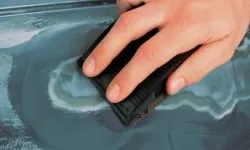
WATER SANDPAPER: Types and Numbers or Measures

La inteligencia artificial (IA)

WOOD VARNISH: Colors, Price, In Spray
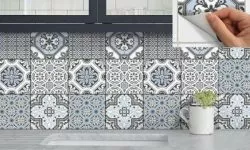
ADHESIVE TILES: Prices, Brands and Types or Models
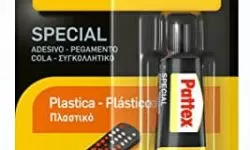
WATERPROOF GLUE For Wood and Plastic

LABORATORY EQUIPMENT: Names and Functions
Other Topics of Interest in ALPHAPEDIA

FREE BACHELOR DEGREE IN ASTRONOMY

FREE BACHELOR DEGREE IN RELIGIOUS STUDIES

FREE MASTER DEGREE IN ARCHITECTURE

FREE BASQUE LANGUAGE COURSE

FREE BACHELOR OF AYURVEDA DEGREE

FREE MASTER DEGREE IN VISUAL ARTS
Screw Drawing
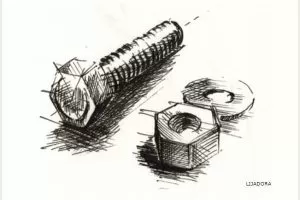
Screw Image
